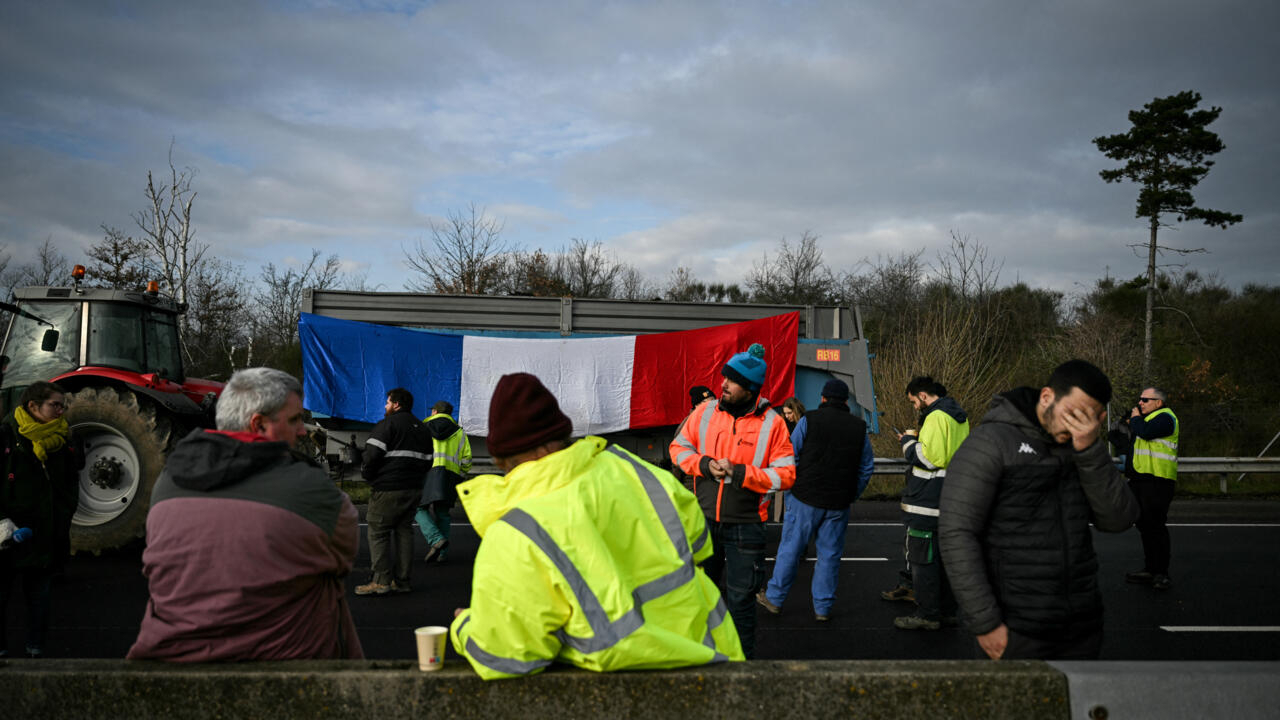France’s farming crisis in numbers

[ad_1]
The protests sweeping across France have cast a renewed focus on the plight of farmers, a shrinking and ageing category at the mercy of volatile prices and grappling with a bleak economic outlook. FRANCE 24 talks to an economist and a unionist about the key figures behind France’s farming crisis.
French farmers expanded their roadblocks on Wednesday in protest at plunging food prices, soaring costs and crippling regulations they say are killing their livelihoods.
The protests, part of a rising tide of anger among agricultural producers across the European Union, pose a major challenge to President Emmanuel Macron’s government, coming just months ahead of European elections.
The turmoil has reopened a sensitive debate in France, the EU’s leading agricultural producer, which has seen the number of farmers shrink from 2.5 million in the 1950s to fewer than half a million today.
France’s farming population has not only shrunk dramatically; it is also older than ever before. According to the latest available census, farmers averaged 51.4 years of age in 2020, up from 50.2 in 2010.
Of the 496,000 farmers counted in 2020, almost 200,000 – two fifths of the total – will be eligible for retirement by 2026. Meanwhile, aspiring younger farmers are being priced out of the industry, unable to invest in land and property.
“Young people who want to go into farming have to invest hundreds of thousands, if not millions, of euros in a profession that is known to be tough, with long working hours, on-call duty, few holidays and a fluctuating income,” says economist Alessandra Kirsch, head of studies at the French think tank Agriculture Stratégies.
“The loan repayments they have to make in the first few years are too high compared to the meagre profits generated by farms,” she explains.
Read moreWhy French farmers are up in arms: fuel hikes, green regulation, EU directives
Improving the sector’s attractiveness is crucial to its survival, adds Yohann Barbe, a cattle farmer from eastern France who sits on the board of the FNSEA, France’s main farming union.
“We need to offer people the prospect of better working conditions,” he says. “We’re lucky enough to work in contact with nature, but we have to be able to make ends meet too.”
-
100,000 fewer farms in one decade
The corollary of a shrinking workforce is an almost symmetrical decline in the total number of farms, down by almost 21% between 2010 and 2020 – a loss of around 100,000 businesses in the space of a decade.
Kirsch points to major hurdles in handing over farms from one generation to another, owing to both the cost of properties and the lack of candidates.

“Not to mention the fact that the value of agricultural production decreases over time: to produce the same wealth, you need more capital and more labour,” she adds. “That’s why you end up with bigger farms that employ more people, but earn no more.”
The latter trend explains why the actual farming area has remained largely stable between 2010 and 2020, shrinking by just 1% nationwide.
The hardship experienced by farmers has been blamed for a significantly higher suicide rate than the wider population.
In 2020, the rate of suicide among farmers aged 15 to 64 was 43.2% higher than the national average, according to figures compiled by the Mutuelle sociale agricole (MSA), the agricultural sector’s main health insurance provider.
“It’s a profession that requires a lot of work and knowledge of many fields (business, administration, agronomy), and which is constantly under fire,” says Kirsch. “Reconciling professional and social is not easy in such circumstances, and it’s easy to lose one’s footing.”
For Barbe, the cattle farmer, agricultural workers have been left behind while the rest of the professional world adapted to changing times.
“Nowadays, when we sit down for our evening meal on Sundays, I’m the only one who gets up to go look after the cows,” he says.
-
Poorer and more vulnerable
Struggling to cover costs and bills, while fretting over uncertain earnings, is an all too familiar experience for most farmers.
At 17.4%, the share of farming households who live below the poverty threshold is higher than among blue-collar workers (13.9%) and clerical workers (12.1%), and almost twice as high as the national average (9.2%), according to INSEE, the national institute of statistics.
Read moreIn pictures: French farmers block roads, bridges as protests sweep country
Farmers’ greater vulnerability is a consequence of their high income volatility, says Kirsch.
“Market prices can change in a matter of weeks, and a weather hazard can wipe out a harvest in a matter of hours. In other professions, you can negotiate your salary, set your selling price and make forecasts. In agriculture, you don’t know what your income will be until you’ve harvested and sold – and it’s not you who sets the price.”
Wild fluctuations in grain prices are indicative of the challenges farmers face.
The price of wheat slumped to €214 per ton in December, its lowest level in over two years and less than half its value in May 2022, according to the Euronext stock exchange.
Kirsch points to several factors behind this sharp drop, starting with the abundant Russian stocks that allow Moscow to sell its wheat at ultra-competitive prices, out-competing the French.
Adverse weather conditions have compounded French farmers’ disadvantage.
“It was difficult to get tractors into flooded fields to prepare the soil and sow at the right time,” Kirsch explains. “We are therefore expecting a poor harvest, combined with prices that are below production costs.”
This article is a translation of the original in French.
[ad_2]




